(完整版)大学一年级英语语音练习手册教学计划
英语语音教学计划
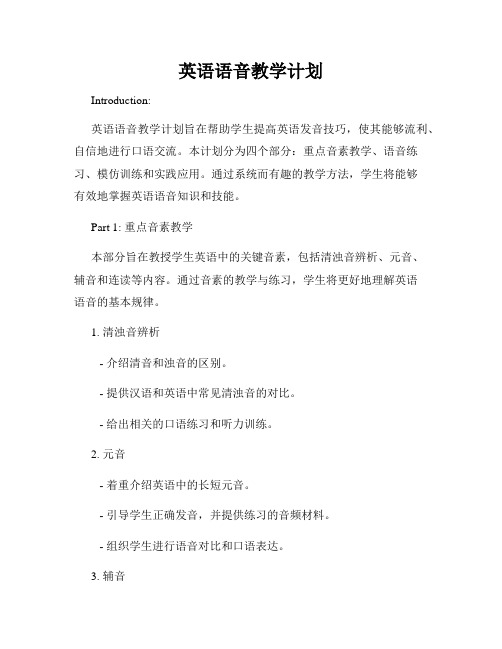
英语语音教学计划Introduction:英语语音教学计划旨在帮助学生提高英语发音技巧,使其能够流利、自信地进行口语交流。
本计划分为四个部分:重点音素教学、语音练习、模仿训练和实践应用。
通过系统而有趣的教学方法,学生将能够有效地掌握英语语音知识和技能。
Part 1: 重点音素教学本部分旨在教授学生英语中的关键音素,包括清浊音辨析、元音、辅音和连读等内容。
通过音素的教学与练习,学生将更好地理解英语语音的基本规律。
1. 清浊音辨析- 介绍清音和浊音的区别。
- 提供汉语和英语中常见清浊音的对比。
- 给出相关的口语练习和听力训练。
2. 元音- 着重介绍英语中的长短元音。
- 引导学生正确发音,并提供练习的音频材料。
- 组织学生进行语音对比和口语表达。
3. 辅音- 分类介绍英语中的辅音,并重点指出难点音。
- 提供正确的发音示范,并进行实践练习。
- 引导学生通过对比分析,改正自身发音问题。
4. 连读- 引导学生了解英语中的连读规则。
- 提供有关连读的示例,并进行模仿训练。
- 鼓励学生通过口头练习加强连读技巧。
Part 2: 语音练习本部分旨在通过各种练习活动帮助学生巩固所学的语音知识,并提高发音准确性和流利度。
1. 单词发音- 提供一系列基础词汇、常用短语和句子的发音练习。
- 引导学生注意重音和音调,并加强语音与语义的联系。
2. 对话练习- 提供真实生活对话材料,帮助学生练习正确的语音语调。
- 分角色进行模拟对话,帮助学生将所学语音知识运用到实际场景中。
3. 句子朗读- 提供不同类型的句子,要求学生朗读并重点发音。
- 教师通过示范和纠正,提高学生的语音发音水平。
Part 3: 模仿训练本部分通过模仿外教或标准的英语录音材料,让学生尽可能地接近地道英语。
通过反复模仿,学生将逐渐形成优秀的语音习惯。
1. 视频教学- 提供各种语音发音视频材料,学生通过观看并模仿,加强自己的发音技巧。
- 学生可反复观看和模仿,直至能够准确地复制目标音。
英语语音教学计划计划6篇
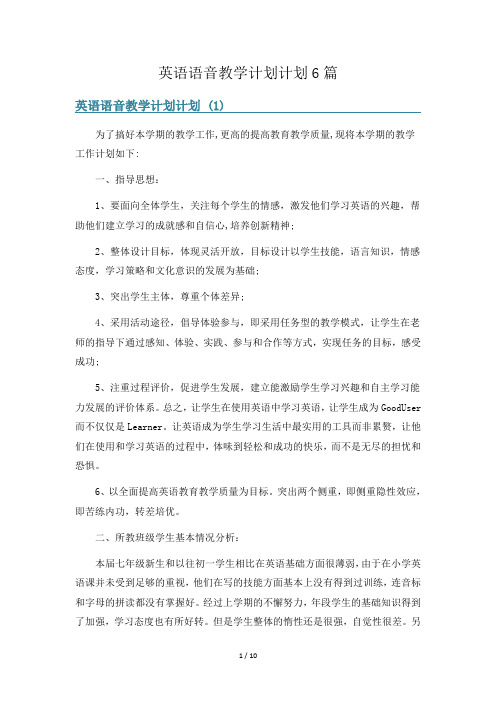
英语语音教学计划计划6篇英语语音教学计划计划 (1) 为了搞好本学期的教学工作,更高的提高教育教学质量,现将本学期的教学工作计划如下:一、指导思想:1、要面向全体学生,关注每个学生的情感,激发他们学习英语的兴趣,帮助他们建立学习的成就感和自信心,培养创新精神;2、整体设计目标,体现灵活开放,目标设计以学生技能,语言知识,情感态度,学习策略和文化意识的发展为基础;3、突出学生主体,尊重个体差异;4、采用活动途径,倡导体验参与,即采用任务型的教学模式,让学生在老师的指导下通过感知、体验、实践、参与和合作等方式,实现任务的目标,感受成功;5、注重过程评价,促进学生发展,建立能激励学生学习兴趣和自主学习能力发展的评价体系。
总之,让学生在使用英语中学习英语,让学生成为GoodUser而不仅仅是Learner。
让英语成为学生学习生活中最实用的工具而非累赘,让他们在使用和学习英语的过程中,体味到轻松和成功的快乐,而不是无尽的担忧和恐惧。
6、以全面提高英语教育教学质量为目标。
突出两个侧重,即侧重隐性效应,即苦练内功,转差培优。
二、所教班级学生基本情况分析:本届七年级新生和以往初一学生相比在英语基础方面很薄弱,由于在小学英语课并未受到足够的重视,他们在写的技能方面基本上没有得到过训练,连音标和字母的拼读都没有掌握好。
经过上学期的不懈努力,年段学生的基础知识得到了加强,学习态度也有所好转。
但是学生整体的惰性还是很强,自觉性很差。
另外,学生在情感态度,学习策略方面还存在诸多需要进一步解决的问题。
例如:很多学生不能明确学习英语的目的,没有真正认识到学习英语的目的在于交流;有些同学在学习中缺乏小组合作意识;大多数同学没有养成良好的学习习惯,不能做好课前预习课后复习,学习没有计划性和策略性;不善于发现和总结语言规律,不注意知识的巩固和积累。
三、主要教学工作:1、以优化课堂结构,提高教学效率为中心。
向45分钟要质量,要做到这点我要做到提前备课,没有教案不得进课堂;认真上好每一节课。
(完整版)大学一年级英语语音练习手册教学计划

《英语语音》教课纲领一、课程名称:英语语音二、课程类型:专业选修课三、教课时数:周学时数 2 ,总学时数 20四、学分: 2五、开课时间:第二学期六、开课专业:英语专业七、教课对象:英语专业本科一年级学生八、教课目标:英语语音课的目的是向学生系统介绍英语语音和语调的知识,使学生经过学习和练习掌握英语的发音、语流的规律、语调的功能,基本上能正确使用英语语音、语调朗诵、表达思想并进行社交。
九、课程内容:本课程要求以学生练习为主,从听辨语音、语调能力的培育下手,将听力、发音与口头表达三方面的训练密切联合起来,既重申基本功的训练,又注意活用练习。
教课内容要求突出以下几方面:(1)英语音素的正确发音方法、辨音能力、模拟能力综合训练;(2)英语的单词重音及语句重音的基本规律、表现形式、表意功能的讲解与训练;(3) 英语语流的节奏规律、基本特点、基本因素、强∕弱读式的训练; (4)英语所独有的语音、语调的构造、功能及其在社交中的运用。
十、教课时间安排:学期周内容学时1Pretest, Unit 1 Basic Concepts: Syllables, Stress & Rhythm22Unit 2 Consonants: Stops2第3Unit 3 Consonants: Fricatives & Affricates2一4Unit 4 Consonants: Nasals, Approximants&学Lateral(s)2期5Unit 5 Vowels: Front Vowels & Central Vowels2 6Unit6 Vowels: Back Vowels27Unit 7 Vowels: Diphthongs28Unit 8 Stressed Syllables & Unstressed Syllables219Unit 9 Stressed Words & Unstressed Words in a Sentence210Unit 10 Strong Forms & Weak Forms211Unit 11 Linking212Unit 12Rhythm of English Speech213Unit 13Types of Intonation in English214Unit 14Intonation Units of English215Unit 15Functions & Uses of English Intonation2十一、所用教材:(1)《英语语音教程》王桂珍编著高等教育第一版社, 2000(2)《大学一年级英语语音练习手册》张冠林编外语教课与研究第一版社, 1988十二、教课参照书目:(1)《国际音标与语音》汪福祥李孚声著外文第一版社, 1999(2)《国际音标与语音语调》张卓宏王文广等著清华大学第一版社 , 2003(3) Cruttenden, A. Gimson's Pronunciation of English, 外语教课与研究第一版社, 2000(4) Hancock, M. English Pronunciation in Use, Cambridge University Press, 2003(5) Roach, P.English Phonetics and Phonology,Cambridge University Press, 1983.十三、查核方式:学期末考试与平常成绩和讲堂表现相联合。
大学一年级英语语音练习手册 Chapter 7
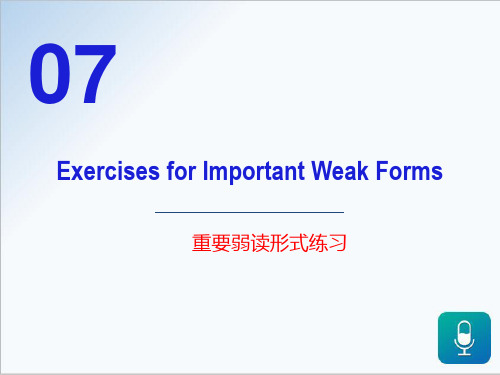
for /fɔ:/
/fə/ This watch will last for ever!
There’s a parcel here for you.
I can’t tell one from the other.
from /frʌm/ /frəm/ I’ve just heard from Mary.
I am Peter. 句中的be动词am 被强调,采用强读式,读作/æm/。
虚词弱读的读音变化规律
Weak Forms
弱读
主要弱读内容: 限定词、介词、连词、 助动词、代词等。
主要弱读形式: 改变元音的方式 省略音节的方式
Cases a, an am and are
Normal form
I gave him a book. Give him my best wishes. Tell him to come. Who’s in the bathroom? What’s the matter? The man’s in the kitchen.
Cases
Normal form
me /mi:/
must /mʌst/CaBiblioteka esNormal form
Weak form
Examples
What does he do for a living?
does /dʌz / /dəs/ Where does this road lead to?
Where does your brother live?
Is this for me?
07
Exercises for Important Weak Forms
重要弱读形式练习
强读和弱读是英语语音学习中不易掌握的一个 难点,特别是弱读式就更难一点。
大学一年级英语语音练习手册 Chapter 9
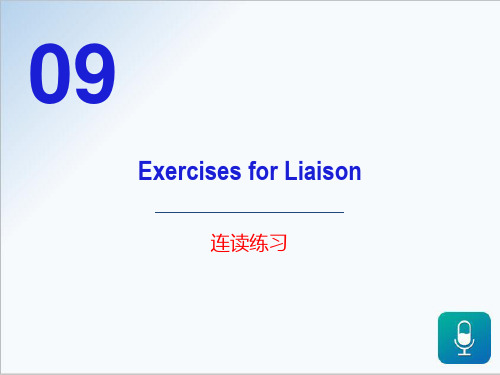
如果前一个词是以r或者re结尾,后一个词是 以元音开头的话,这种情况下r或者re不但要发出r 的声音,而且还要和后边的元音拼读起来。这样 一个发音规则,尤其在英式发音当中更加明显。
They're my father~and mother. I looked for~it here~and there. There~is a football under~it. There~are some books on the desk. Here~is a letter for you. Here~are four~eggs. But where~is my cup?
09
Exercises for Liaison
连读练习
liaison
连读
1. Consonant+ Vowel
在同一个意群里面,如果相邻的两个词中的前 一个词是以辅音结尾,后一个词如果以元音开头, 这种情况下就要将辅音和元音拼起来连读。
It~is~an~old book. Let me have~a look~at~it. Ms Black worked in~an~office last~yesterday. I called~you half~an~hour~ago. Put~it~on, please. Not~at~all. Please pick~it~up.
4. Vowel + Vowel
一个词语元音结尾的话或一个词语元音开头, 那这两个因往往也要自然而不间断的连读到一起。
I~am Chinese. He~is very friendly to me. She wants to study~English. How~and why did you come here? She can't carry~it. It'll take you three~hours to walk there. The question is too~easy for him to answer.
语音练习手册
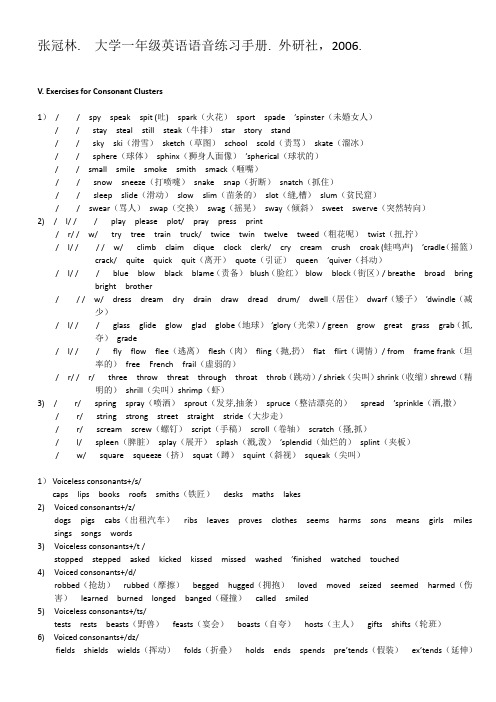
张冠林. 大学一年级英语语音练习手册. 外研社,2006.V. Exercises for Consonant Clusters1)// spy speak spit (吐) spark(火花)sport spade ’spinster(未婚女人)// stay steal still steak(牛排)star story stand// sky ski(滑雪)sketch(草图)school scold(责骂)skate(溜冰)// sphere(球体)sphinx(狮身人面像)’spherical(球状的)// small smile smoke smith smack(咂嘴)// snow sneeze(打喷嚏)snake snap(折断)snatch(抓住)// sleep slide(滑动)slow slim(苗条的)slot(缝,槽)slum(贫民窟)// swear(骂人)swap(交换)swag(摇晃)sway(倾斜)sweet swerve(突然转向)2) /l/ // play please plot/ pray press print/r/ /w/ try tree train truck/ twice twin twelve tweed(粗花呢)twist(扭,拧)/l/ // /w/ climb claim clique clock clerk/ cry cream crush croak (蛙鸣声) ’cradle(摇篮)crack/ quite quick quit(离开)quote(引证)queen ’quiver(抖动)/l/ // blue blow black blame(责备)blush(脸红)blow block(街区)/ breathe broad bring bright brother// /w/ dress dream dry drain draw dread drum/ dwell(居住)dwarf(矮子)’dwindle(减少)/l/ // glass glide glow glad globe(地球)’glory(光荣)/ green grow great grass grab(抓,夺)grade/l/ // fly flow flee(逃离)flesh(肉)fling(抛,扔)flat flirt(调情)/ from frame frank(坦率的)free French frail(虚弱的)/r/ /r/ three throw threat through throat throb(跳动)/ shriek(尖叫)shrink(收缩)shrewd(精明的)shrill(尖叫)shrimp(虾)3) /r/ spring spray(喷洒)sprout(发芽,抽条)spruce(整洁漂亮的)spread ’sprinkle(洒,撒)/r/ string strong street straight stride(大步走)/r/ scream screw(螺钉)script(手稿)scroll(卷轴)scratch(搔,抓)/l/ spleen(脾脏)splay(展开)splash(溅,泼)’splendid(灿烂的)splint(夹板)/w/ square squeeze(挤)squat(蹲)squint(斜视)squeak(尖叫)1)Voiceless consonants+/s/caps lips books roofs smiths(铁匠)desks maths lakes2)Voiced consonants+/z/dogs pigs cabs(出租汽车)ribs leaves proves clothes seems harms sons means girls miles sings songs words3)Voiceless consonants+/t /stopped stepped asked kicked kissed missed washed ’finished watched touched4)Voiced consonants+/d/robbed(抢劫)rubbed(摩擦)begged hugged(拥抱)loved moved seized seemed harmed(伤害)learned burned longed banged(碰撞)called smiled5)Voiceless consonants+/ts/tests rests beasts(野兽)feasts(宴会)boasts(自夸)hosts(主人)gifts shifts(轮班)6) Voiced consonants+/dz/fields shields wields(挥动)folds(折叠)holds ends spends pre’tends(假装)ex’tends(延伸)for Incomplete Plosion , Nasal and Lateral Plosionplosion1)Plosives + plosives`active `blackboard `bookcase `post-card Sep`tember`put `down / `wet `ground / `next `door / `stop `talking / `keep `quiet / `take `care / ` not `bad / `great `concern / `hard `times / `quite `different/ `waste/`time / a `great deal2)Plosives +Fricatives(1)`friendship `first / `old `friends / `step `forward(向前走)/ `red `flags / a bright `future(光明的前程) / `sweet `flowers /`ripe fruit / a com`plete `failure(彻底的失败)/ ad`vance/ ad`vice / a `kind `voice / a `one-sided `view(片面的观点) / `first `visit/ `second `volume (第二卷) / `constant `vigilance(始终警惕) / a com`plete `victory(2)`just `think / a `thousand `thanks(万分感谢) / `get `through(通过) / `take `three/ `bright `thought / the `right `thing/ `abstract `theory(抽象的理论) / `black `thread / `get `there / `just `then / `take `this / `ask them(3)`red `stars / `bright `sky / `first `step(第一步) / `keep `silent(保持安静) / `short `stories / `folk `songs(民歌) / `deep`snow / a `great suc`cess / a `good `season/ a `big `zoo / a `good `zipper(一条好的拉链)(4)`bookshelves / `first `shift(第一班)/ `don’t `shout / `look `sharp / `make `sure(确保)/ a `good `shot (一个好球)/ a`smart shirt (一件漂亮的衬衣) / a `public`show(公演)3)Plosives+Affricates`white`chalk / `great`changes/ `loud`cheers(大声欢呼)/ a`good`try/ a`good`child/ the`first`chapter(第一章)/ a`bit`dry / a`second`choice / a`good`job/ a`black`jacket/ a`big`tree/a`big`jar/ a`hard`journey/ `excellent`judgement(精辟的判断)/ a`fast`train/ a`sweet`dream/ a`cold`drinkPlosion/,+,/ good`morning/ at`tend`meetings/ `not`mine/ `help me/ a`good`memory(好记忆)/ a`different`meaning/ an im`portant`matter/ `midnight(午夜)/ at`noon/ `not`now/ `don’t`know/ `odd`numbers(单数)/ `quite`near/ `good`news/ `urgent`needs/ a`loud`noisePlosion/,+/ `little `battle(战斗) ` bottle `cattle(牲口) `gentle(文雅的) `kettle(水壶) `settle `title(头衔) ` bundle(包,捆) `candle(蜡烛) `handle(把手) `idle(懒散的) ` middle `paddle(涉水) `needle`boldly(大胆地) `friengly `hardly `loudly `proudly `rapidly at`least/ at`last/ at`leisure(闲着的)/ at`lunch/ at`liberty(自由的)An`outline(大纲)/ a`red`lantern(红灯笼)/ the`third`lesion/ a`good`leader/ the`second`longest(第二长)Ⅶ.Exercises for ImportantWeak Formsa,an /, /a `lion/ a `table / an ungly `man / an `hour / an `honest `man / aEuro`pean / a uni`versity / `what a pity! / You’ll `need an axe. / An `apple a `day `keeps the `doctor away.(每日一苹果,不必看医生)am/ , /I’m `all right. / I’m `not `ready yet. / I’ve seen him and am `glad to`say he’s well. / `What am I to do / I’m in a `terrible hurry.(我急着要[走])/`Where am I nowand/ d, /`Two and `six / `fire and the `sword / `Tom and `Annie / `John and`Kate left early. / `Give `Jack `four and a penny. / `Go and `tell yourUncle. / a `cat and `dog life (充满争吵的生活)are/ /The `boys are here. / Our `friends are out. / Are you there / `What are you doing/ These `things are `all mine./ Are you ready to go nowas//as good as gold ([小孩]很乖)/ as far as I know(就我所知)/It look as if you`re right./ Do as you`re told. It isn`t as good as I thought./ I`ll stop now, as it`s late .at//I`m looking at the clock./ Tom`s still at school./He`ll be back at six./I`ll meet you at the gate./You`ll see a bank at the corner./At any rate, that`s not bad!be//Don`t be late./ Do be quiet./I`ll be ready soon./Come on, I don`t want to be late!/We shall be there in plenty of time. been//You`ve been a long time./ All the work`s been done./I`ve been cheated!/We`ve been playing chess./I wish I hadn`t been so hasty.(如果我不是那样草率就好了)but//It`s old but useful./We`ve nothing but water./ It`s raining but I`ll o out./ Jack`s careful but not very bright.( Jack很认真但不聪明)/ That`s nothing but nonsense.can//`What can I `do to help you/ I can `see it `quite well./I can `smell gas./ `That can be `done in a minute./ Can you `do me a favor(能帮我个忙吗)could//I could `leave early./ `What could I do /The `dress could be altered.(衣服可以改)/I `wish I could swim./You could `do it if you tried./We could `put you `up for the night.(我们可以让你过夜)do/,/`What do you want/ `Where do you buy them/ Where do you get them/Do you `really `think he is stupid/ `Why do you `work so harddoes //`What does he do for a living (他靠什么生活)/ `Where does `this `road lead to(这条路通到哪里)/`Where does your `brother live/`How does that affect you (那件事对你影响如何)/ `How on `earth does it workfor//Is `this for me / `This `watch will `last forever!/ There`s `parcel here for you./`This`ll be good for you.(这对你有好处)/For `years and `years I`ve `said it would happen .(多少年来我一直在说这事会发生)/It was `art for art`s sake.(那是为了艺术的艺术)from//I `can`t tell `one from the other./ I`ve `just `heard from Mary./He`s a `visitor from Italy./He `can`t tell `red from green.(他不能区分红绿二色)had has have /,/ /,/ /,/Has the `post come(邮件来了吗)/Had I know, I`d have told you about it./ When `Tom had finished, he left./`Cook has `burned the cakes./ The `guests have arrived./ They`d gone./ We`d `better hurry./ You`ve `made a mistake./ That`s `never oc`curred before./Has your `friend `got `over the incident(你朋友已经摆脱事故的影响了吗)he/,/He `told me a story./ `What was it he said/ He`s a `good boy./ He`s `gone be`fore I arrived.her /,/I `gave her a book./ She`s `got her ticket./ Her `answer sur`prised her father./ They `gave her a `lot of `good advice. him //I `gave him a book./ `Give him my `best wishes./ `Tell him to come./ I met him once./ I `don`t know him and I don`t want to know him.is/,/`Who`s in the bathroom/ `What`s the matter/ The `man`s in the kitchen./ His `wife`s Italian./ `What`s the use of grumbling(抱怨有什么用处) /That `fellow`s a scoundrel.(那个人是个坏蛋)me //He `gave me my ticket./ They `want me to do it./ `Bill `taught me to swim./ `Don`t `look at me like that, is `makes me nervous .must //You must `eat it at once./ He must `go now./ You must re`member you`re `only a beginner./ I must `make a note of that.(我得把这事记下来)/ `That must be done at once.of //`One of the `books is missing./ It`s `made of `cheese and eggs./ The `jug is `full of cream./ I`ve `never heard of it./ `That `one`s the `best of the bunch.(那人是这些人中最好的)shall /l/`When shall I see you again/ I shall be `back soon./ Shall I `see you home/ `What shall we tell him when we see him/ I shall be `thirty `next `Wednesday.(下个星期我就30岁了)she //`What did she say/ She `said she was in a hurry./ She `told me she `hadn`t time./ She `doesn`t like plums, doesn`t she should /d/What should I say/ We should `get there `early by `that train./ You should be careful, my boy./ I should be `much obliged to you.(我非常感谢你)/ `Everyone should `try to do good.(大家都应该做好事)some /,/Would you `like some milk/ I`ve got some letters for you ./ `Give him some more./ Have you `got some `good coffee/ He `bought some eggs, some bacon and some bread.than //It`s `bigger than I thought./ `That`s `more than I want./ `That`s `more than enough./ `Don`t `eat `more than your share.(别吃得过量)that//He `said that he was late./ I `told him that he was lazy./ Well, `this is the `best that I can do.them /m/I`ll `give them back./ We `saw them yesterday./ `Please `hand these pens to them./ `Give then my regards.(代我向他们问好)/ `If I see them, I`ll `tell then what happened.there //There`s a `club a`round the corner.(拐弯处有个俱乐部)/ `Is there a can`teen here(这儿有吃饭的地方吗)/ There was a `strange l`ook in his eyes.(他眼中流露出一种奇异的神情)/ `Oh dear, there isn`t `any `bread left.to /,/I `want you to `work hard./ They `went to the zoo./ Do you `want to go `Oh, yes, I`d love to./ `Last `year they `went to India.us//They `told us to go./ I `wonder if they saw us./ `Let`s `go out now./ They `gave us a `cordial welcome.(他们热情欢迎我们)was /s/`What was he saying/ Was` anyone hurt(有人受伤了吗)/ `That was splendid./ He `said his `friend was an artist./ `What was his `expla`nationwe //We `saw him there, didn`t we/ `What shall we do/ We`ll `go tomorrow./ We`d `like a drink./ We`ve `not `much time./ `Why are we waitingwere //The `boys were busy./ They were `all at home./ `What were you doing/ There were `several foreigners here./ `Why were you so angry with himwould /,/`What would you like/ `What would be the `best thing to do/ `John would help you if you asked him./I`d do it if I could./ We`d `love to go./ You`d succeed if you tried.(只要坚持你就会成功)Materials for the Practice of Pausing1`Unlike the aeroplane,/ `helicopter can `fly `straight `up and down./ An `aeroplane `travels `very fast / `even when it is `coming down ,/ so it `needs a very large `field to `land in./ It can `even `land safely on the `flat `roofs of buildings.2The `year has `four seasons :/spring,/ summer,/ autumn and winter. A `month has `thirty or thirty-`one days./ A `week has seven days:/ Monday,/ Tuesday, / Wednesday, / Thursday , / Friday / Saturday and Sunday .The `day has `twenty-`four hours, / an hour `sixty minutes / and a minute `sixty seconds.3An `airport is a `very `busy place,/ These are `all `near one another , / and the `most im`portant `one is the con`trol tower, / from `which `signals by `wireless are made / to ar`riving and de`parting planes./ If the `airport is some `distance from a town or a `railway station, / `buses may be `provided for the con`venience of passengers.New Wordsaeroplane /` /n. 飞机helicopter /`ɒ/ n . 直升飞机straight // ad. 直接地hover /`ɒ/ v. 盘旋alight /`/ v. 降落gently /`/ ad. 轻轻地settle /`/ v. 飞抵,飞下passenger /`/ n. 乘客space // n. 空间roof // n. 房顶leap year闰年airport /`/ n. 飞机场runway /`/ n. 跑道land // v. 着陆take off 起飞control tower控制塔signal /`/ n. 信号wireless /`/ n. 无线电arriving and departing planes抵达机场的或离开hangar /`/ n. 飞机库起飞的飞机overhaul /`/ v. 大检修repair /`/ v. 修理customs offices海关hotel /`/ n. 旅馆distance /`/ n. 距离provide /`/ v. 提供convenience /`/ n.方便Exercises Mark the places where pauses should be made:1Much of the paper we use is made from trees. Woodsmen go into the forest and cut down the trees. Other men cut the trees into logs which are taken to the paper mill. There large saws cut the logs into very small pieces about sixteen inches long. These are then cut into very small pieces by many sharp knives. Now large vats which look like big flat barrels receive the small pieces. In these vats the pieces are made into what is called pulp. This pulp is laid on copper nets and run between heavy hot rollers that press it into paper. At last, after going between many rollers,much of the paper is wound into rolls and placed in a storehouse ready to be used.woodsman /`/ n. 伐木工forest /`ɒ/ n. 森林log /ɒ/ n. 圆木saw // n. 锯子inch // n. 英寸vat // n. 大桶barrel /`/ n. 圆桶pulp // n. 纸浆copper /`ɒ/ n. 铜net // n. 网状物roller /`/ n. 滚筒press // n. 挤,压wound // v. 弯曲(动词wind的过去分词)storehouse /`/ n. 仓库2Have you ever seen a forest fireIt is a terrifying thing to see the flames run along the ground licking up the leaves and dead wonder those whose homes are near gather quickly to fight the the fire cannot be stopped,these people will lose everything .water can seldom be used to put out a forest fire for most of the time water is not of using water the men fight fire with hoes,shovels,and rakes they make a broad,chean path through the forest some distance ahead of the they set “backfires”along that side of this clean path which lies toward the coming backfires burn slowly toward the main they meet both must die out for lack of fuel.flame // n. 火焰lick /(火焰等)掠过,吞没branch // n. 树枝put out扑灭available /`/ a. 可以得到的,在手边的hoe // n. 锄头shovel /`/ n. 铲子rake // n. 耙子backfire / `/ n. 回火(以火灭火)fuel // n. 燃料3Most of us like to eat most people do not know what part of the potato is best for a sharp knife and cut from the middle of the potato a slice as thin as the slice between your eyes and the will see that the potato has a skin,an outside rim,and an inside outside rim which is immediately beneath the away with the the skin itself is better for food than the eating a baked potato,if you scoop out the inside and leave the outside you are wasting the best part of you cannot eat the whole potato,eat the outside rim and leave the inside.New Wordspotato /`/ n. 土豆slice // n. 片skin // n. 皮,壳rim // n. (圆形物的)边valuable /`/ a. 宝贵的baked potato烤土豆scoop // v. 挖4A boatman wanted to cross a had to take with him a goat,a wolf and a basket of boat was so small that he could take only one of them at a time. “If I leave the wolf and the goat together,the wolf may eat the goat,”he said to himself. “If I leave the goat and the cabbage together,the goat may eat the cabbage.”What did the boatman do to solve the problemThe solution:First of all the boatman took the goat across in the left the wolf and cabbages quite safely on the bank,because wolves do not eat he came back and took the cabbagaes left them on the other bank and came back with the goat because he could not leave the goat with the he left the goat behind and took the wolf acros .He left the wolf on the other bank with the cabbages and then came back to fetch the this way he took them all across safely. boatman /`/ n.船夫cross/ɒ/ v.渡过goat // n.山羊wolf /l/ n.狼cabbage /`/ n.白菜solve /ɒl/ v.解决problem /`ɒl/ n.问题bank // n.岸fetch // v.带走safely /`l/ ad.平安无事地IX. Exercises for Liaison+VowelCome in / work out/ good idea/ think of it/ read it again/ speak English/ first of all/ not at all/ all of us/ look at it/ pick it up/ put it on/ take it along/t ake it away/ leave it alone/ an hour /an egg/ an end/ in an hour/ in August / in an instant/ put on/ put it on/ put it up /let him in / best of all/ take it out/ back in a minute/ an hour and a half/ one of us/ make it up /a cup of tea/ a bottle of ink / a bowl of rice /a box of sweets/ keep on/ above all/ stand up/ take off/ take it off2.-linkingThere is/ there are / our own / more over/ for ever/ after all/ far away/ here and there/ father and mother / remember it/ for instance /later on/clear enough /for a moment /for an hour/ ]+VowelI am / you are / she is / go out ./ any other / too often / go on / try it / try again / throw away / no objection / very interesting / highly important / day in and day out / go away / no end / see off / stay up / we agree / May I/ who else / how oldStress1)Single Stressa. `modern(现代的)`people `industry (工业)`policy (政策)`ordinary `agriculture (农业)b. be`gin suc`cess(成功) ad`vantage(利益)re`public(共和国)a`cademy (学院)de`mocracy (民主)con`temporary (当代的)vo`cabulary(词汇)2)Uneven (Primary & Secondary)Stress`maga`zine `inter`fere(干涉)`ante`cedent (先行的)`mathe`matics(数学)`conti`nuity(连续性)`uni`versity `excita`bility(兴奋性)fa`mili`arity(熟悉)3)Double (even)Stress`Chi`nese `thir`teen `bourgeoi`sie(资产阶级)`Indo`nesie(印度尼西亚) `Ale`xander(亚历山大)Shifts1)Rhythmical Stress2) Contrasting StressStress1 )content words(nouns,notional verbs,adjectives,adverbs,demonstrative and emphatic pronouns,interrogative words,interjections)are usually stressed.Honesty is the best policy.(诚实是上上之策)/He would die rather than yield.(他宁死不屈)/It’s better to be to early than to be too late.(宁可早到也不要迟到)/Better to do well than to say well.(说得好不如做得好)/Better late than never.(迟到总比不到好)/This (that) will do you good./Whose are the magazine/What’s the use of gurmbling(抱怨有何用)2)Structural Words(articles,personal,reflexive and reciprocal pronouns,monosyllabic prepositions and conjunctions ) are customarily unstressed .A rose is a beautiful flower./The strong should help the weak.(强者应助弱者)/They went arm in arm.(他们臂挽着臂一起走着)/That’s the man who helped me ./She studies from morning till night ./This is the best that I can do./That’s more than enough./Do you know who will be there/What can I do to help you / I must make a note of it.3)But for such reasons as rhythm, emphasis,contrast,repetition,parentheses,etc.,structural words may receive different degrees of stress ,while content words may lose theirs.a. A content word,which normally has sentence stress,appearing for the second time in a sentence or in a short context,is not stressed. Study as Lenin studied./Do as the teacher does./She passed the door of a large shop/Suddenly,she decided to enter that door./Go home and stay home ./Is it a new town No,it’s an old town ./What is pink A rose is pink ./What’s blueThe sky is blue./ All is well that ends well.(结果好,就一切都好)/No news is good news.(没有消息就是好消息)b. The word SO, used as a prop word to stand for a whole statement, has no sentence stress.Is he coming I do n’t think SO.c. The word “such” and the expressions “that kind of” and “that sort of”, when they refer to adjectives already mentioned, are unstressed.It was a difficult task. We learn a lot from such tasks./Yes,we should highly value that kind of task.(我们该重视这种工作了)/ On the contrary ,we often try to avoid that sort task .(恰恰相反,我们总是躲避这种工作)/What a delicious apple .I like such apples.d. The nouns “person”,”fellow”, “thing”, “matter”, “business”, and “place”, when they refer to a person or thing just mentioned,are unstressed .These words are usually preceded by a qualifying adjective which is stressed.Zhang’s the finest person I know . / Do you know John He’s a charming fellow.(他是个可爱的人)/Envy is a terrible thing .(嫉妒是件可怕的事)/Learn those idiomatic ways of saying things.(要学会那些习语表达方式)/Why don’t you explain the matter/I don’t understand the affair ./That’s a terrible business.(这事办得糟透了)/ Dalian is a delightful place. It’s one of the best places for a summer holiday .e. The ph rases “a sort of” and “a kind of ”, when used indefinitely are unstressed just as the indefinite pronoun “some ”is.There was a sort of curiosity in his voice. (他的声音中透着好奇) /They came to a kind of agreement./ At first, we thought the book boring. But later, we found a sort of interest in it. (开始我们觉得这本书没意思,后来却发现有点意思)f. The adverb “again ”, when it means “a second time”, “another time ”or “once again ”,is stressed .But when it is used as an intensifier to emphasize a contrast ,it is not stressed.He has gone out and come back again. /After reading a book, put it back on the shelf again. /He was sick and is well again. / Welcome home again.g. The word “street” in names of streets is never stressed.Downing Street(but York Road)(英国伦敦唐人街[英首相官邸所在地])Tenth Street (but Fifth Avenue)/Wang Fujing Street (But Sanhuan Road)h. In the phrases “and so forth” and “and so on ”, the final adverbs “forth” and “on” are not stressed.And so forth. / And so on.Rhythm causes variations in word stress. In words of two syllables having two stresses, the first of the stressed syllables loses its stress when immediately preceded by another stressed syllable.The number of men was eighteen. /The Chinese people won the victory.i. Similarly, due to the influence of rhythm, many compound adjectives with two stressed receive even stress when they are predicative and only one stress when they are attributive .The teacher of the school was kind-hearted. /The kind-hearted teacher understood the difficulties of the pupils. /When I returned home after ten years, my mother was white-haired. / I was overjoyed to see once more my white-haired mother.XI. Rhythmfor Rhythm1)/OO/`time’s `up (时间到了)/`make `haste(赶快)/`next `week /`work `hard/`good `work/`well `done(干得很好)/`that’s `true/`hold `on(坚持住)/`all `right /`that’s `all/`not `yet /`please `do/`oh, `no/`yes, `please/`no,`thanks2)/O o O/`never `mind/`wait and `see /`leave at `once /`come a`long /`hurry `up/`practise `hard /`word by `word(逐字)/`try it `out /`carry `on/`heart and `soul (全心全意)/`let me `see/`good i`dea /`ring me `up (给我打电话)/`what a `crowd /`quite a `bit /`thanks a `lot /`out of `date(过时了)/`hard and `fast(牢固稳定的)3)/O o O o/`wait a `moment/`let’s get `started (咱们开始吧)/`wait a `minute/`time is `precious/`let me `help you /`glad to `see you /`come and `help me /`glad to `hear it /`quite a `lot of /`go and `get it/`just i`magine4)/o O o O/the `latest `new(最新消息)/a `waste of `time (浪费时间)/a `lot of `noise /a `better `chance /You’re `late for `lunch./I’d `like to `come ./I’m `sure you `will./I’ll `see you `off.(我给你送行)/It’s `hard to `say ./It `doesn’t `work./I’ve `no `idea./Our `time is `up ./It `sounds so `strange.5)/O o o O/`lots to be `done/`Lend me a `hand.(帮我一下忙)/`get in the `crop (收割庄稼)/`clear it a`way /`bring him a`long /`once in a `while(有时)/`hardly e`nough/`nothing at `all/`just for a `while/`drop me a `line (给我写封短信)/`send it by `mail/`right over `there/`not in the `least(一点也不)6)/O o O o O/`carry it a`way/`everything is `clear/`follow my ad`vice(听我的劝告)/`bring along your `friend/`see you in a `week/`try to be in `time(尽量及时)/`come and have a `look/`leave it on the `desk/`cut it with a `knife7)/o O o O o/I’m `glad to `see you./You’re `always `welcome./I `hope you `like it./I’d `like to `hear it./I `beg your `pardon./You’d `better `hurry./I’m `very `sorry./It `doesn’t `matter.8)/o O o o O o o/I’ll `borrow a`nother one./You’ll `get it on `Saturday./They’ve `all gone on `holiday.(他们都去度假了)/It’s `very un`fortunate./Per`haps you’ve `heard of it ./Let’s `open the `other one./The `price has gone `up again.(价格又涨了)9)/o O o o o O o o o/It’s `not the one I `borrowed from you./He `didn’t think It `interesting./Re`member what your `teacher told you./I `took it to a `watch repairer./He `didn’t want to `talk about it.10)/o O o o o O o o o O/I `think it was an `excellent idea.(我想这是个好主意)/There `isn’t really `quite enough for `two./The `bus is more con`venient than the `train./They `finished it the `day before she `came ./We `haven’t got an `envelope to `match.(找不到一个般配的信封)/I `shouldn’t b e sur`prised if she for`got.for Rhythm Practice1) `Bed in SummerIn `winter I `get `up at nightAnd `dress by `yellow candle-light.In summer, `quite the other `way.I `have to `go to `bed by day.I `have to `go to `bed and see.The `birds `still `hopping on the tree,Or `hear the `grown-up `people’s feet`Still `going `past me in the street.And `does it `not `seem `hard to you,When `all the `sky is `clear and blue ,And `I should `like so `much to play,To `have to `go to `bed by DayNew Wordsdress// v.穿衣服candle/`l/ n.蜡烛light/l t/ n 光grown-up /`r` / n 成人,大人2)When the `wind is `in the EastIt’s `good for `neither `man nor beast ;When the `wind is `in the NorthThe `skilful `fisher `goes not forth;When the `wind is `in the `SouthIt `blows the `bait in the `fish’s mouth;When the `wind is `in the West`Then it’s `at its `very best.New WordsNeither /`/ a.两者都不neither…nor … 既不…也不…skilful /`l l/ a.熟练的fisher /`/ n渔民.forth /`/ ad向前. blow // v吹(走)bait /t/ n. 鱼食(饵) at…very best 在…最好的时候3)`Spring, the `sweet Spring ,is the `year’s `pleasant king;Then `blooms `each thing ,then `maids `dance in a ring,`Cold doth `not sting ,the `pretty `birds `do sing _`Cukoo,`jug-jug,`pu-we,to-`witta-woo.By Thomas NasheNew WordsThe year’s pleasant king 原意为”一年中愉快的皇帝”,此处指”春天是一年中最令人愉快的季节” bloom/l/ v.开花Sting/t/v. 刺人maid// n. 女孩子,少女Ring/r/ n. 圈Cukoo,jug-jug,pu-we,t-witta-woo 杜鹃、夜莺等的鸣叫声4)I am coming, `little maiden,With the `pleasant `sunshine laden,With `honey for the bee,With the `blossom for the tree.`Every `little `stream is bright,`All the `orchard `trees are white,And `each `small and `waving shoot,`Has for `thee `sweet flowers or fruit.New WordsMaiden /`me dn/n.少女pleasant /`pleznt/a.愉快的Sunshine /`s n a n/n.阳光laden /`le dn/a. 充满的Honey /`h n/n. 蜂蜜bee /bi:/n.蜜蜂Blossom /`blɒs m/n. 花stream /stri:m/n.小溪Bright /bra t/a.欢快的,明亮的orchard /` d /n.果园Waving /`we v/a. 飘扬的shoot /u:t/n.枝,芽Thee /:/pron.(古)你5)`Evening red and `morning grey,`Send the `traveller on his way;`Evening `grey and `morning red,`Bring the `rain u`pon his head.New WordsGrey //a. 灰色的traveler/l/n.旅行者6)MayfairWill you `go along `with me to `shepherd MarketIt’s `there they `hold the `merriest `Fair in May.Will you `go along `with me to `shepherd MarketIn a `pair of `red –heeled `slippers `very gayI’ll `pick a `bunch of `cowslips for your bodice,And I’ll `tie a `yellow `ribbon in your ha ir,If you’ll `go along `with me to `Shepherd MarketAnd `dance me `round the `Maypole at May-Fair.By Eleanor FarjeonNew WordsMayfair /` /n.五月集市shepherd / `e/n牧羊人Market /`/n.集市hold /l/v.举行Merriest /`e s/的最高级fair /e /n.集市Red-heeled /`e`i:l/a.红色鞋跟的slipper /`l /n.拖鞋,便鞋Gay//a.快乐的bunch/n /n.束,串Bodice /`ɒ/n.(妇女的)紧身围腰cowslip /`zl/n.立金花Tie/a/v.系,栓,扎ribbon /`n/n.缎带Maypole /`l/n. 用花和彩条装饰的五月柱(供少年男女跳舞用)7) `January `brings the snow, `makes our `feet and `fingers glew.`February `brings the rain, `thaws the `frozen lake again.`March `brings `breezes `loud and shrill, `stirs the `dancing daffodil.`April `brings the `primrose sweet, `scatters `daisies at our feet.`May `brings `flocks of `pretty lambs `skipping by their `fleecy dams.`June `brings tulips, lilies, roses, `fills the `children’s `hands with posies.`Hot `July `brings `cooling showers, apricots and gilly-flowers.`August `brings the `sheaves of corn, then the `harvest `home is borne.`Warm Sep`tember `brings the fruit, `sportsmen then be`gin to shoot.`Fresh Oc`tober `brings the pheasant, `then to`gether `nuts is pleasant.`Dull No`vember `brings the blast, `then the `leaves are `falling fast.`Chill De`cember brings the sleet, `blazing `fire and `Christmas treat.New Wordsglow/l/ v. 发热thaw/ / v. 融化frozen/`r zn/ a. 冻冰的breeze/z/ n. 微风shrill/ /r l/ a. 出尖声的stir/t: / v. 摇动daffodil/`/ n. 黄水仙primrose/`r r z / n. 樱草花scatter/ `k t/ v. 散布daisy/`e z / n. 雏菊flock/lɒ/ n. (鸟,羊)群lamb/l/ n. 小羊羔skip// v. 跳fleecy/ `l s/ a. 覆盖羊毛的dam// n. 母兽tulip/`t u:l/ n. 郁金香lily/`l l/ n. 百合花rose/`r z / n. 玫瑰花posy/`z/ n. 花束cooling/`u:l / a. 凉爽的shower/`/ n. 阵雨apricot/rɒt/ n. 杏树gilly-flower/`l fl / n. 紫罗兰花sheave/v /n. 捆, 束corn/n /n. 玉米borne/ / a. (此处指) 运送sportsman/ `ts/ n. 运动员到家的shoot/ u:t / 射击pheasant/`/ n. 野鸡gather nuts 摘坚果dull/l /a. 萧条的blast/l st /n. 疾风chill/t l/ a.寒冷的sleet/l t / 雨夹雪blazing/`l z / a. 燃烧着的Christmas/`r s s / n. 圣诞节treat/t / n.请客(吃饭)。
语音教案
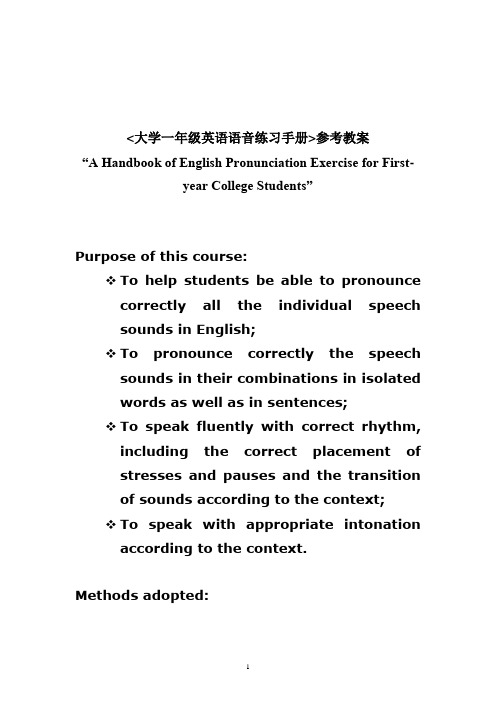
<大学一年级英语语音练习手册>参考教案“A Handbook of English Pronunciation Exercise for First-year College Students”Purpose of this course:To help students be able to pronouncecorrectly all the individual speechsounds in English;To pronounce correctly the speechsounds in their combinations in isolatedwords as well as in sentences;To speak fluently with correct rhythm,including the correct placement ofstresses and pauses and the transitionof sounds according to the context;To speak with appropriate intonationaccording to the context.Methods adopted:sound recognition,tape listening and recording,imitation show,…English consonantThere are 24 consonants in English. These consonants may be classified according to the following:1.place of articulation2.manner of articulation3.voicing, i.e. voiced or voicelessAccording to the place of articulation, consonants can be divided into:1.bilabial (two lips)bio-dental (top teeth/bottom lip)3.dental (tongue tip/top teeth)4.alveolar (tongue tip/tooth ridge)5.post-alveolar (tongue tip/hard palate)6.palate-alveolar (tongue mid/hard palate)7.palatal (tongue mid/hard palate)8.velar (tongue back/soft palate)9.glottal (not localized)According to the manner of articulation we can distinguish:1.stops2.fricatives3.affricates4.nasalsterals6.semi-vowelsEnglish vowelsThere are 20 vowels in English, among which 12 are pure vowels and 8 are diphthongs. A diphthong is a glide from one vowel to another within one syllable.The English pure vowels can be classified according to :1.the height of the raised part of the tongue:2.the part of the tongue raises;3.the position of the lipsEnglish Phonemes IEat it ease isBeat bit seen sinDeed did feel fillDeep dip neat knitLeak lick each itchSeat sit leave liveMeal mill steal stillDiscrimination exerciseeat it atebeat bit betseat sit setfeel fill fellheel hill hellbean bin Benteen tin tenlead lid ledleast list lestcheek chick checklow no rowlot not rotlock knock rocklight night rightlip nip riplap nap raplaw nor rawlice nice riceleading needing readinglocking knocking rockingEnglish Phonemes IIMinimal pairscot court cod cord pot port cock corkfox forks not noughtshot short spot sportsod sword don dawnchock chalk tot taughtodder order hock hawkThis is a story about a robber. He wanted to rob a shop. He was a short man but he climbed over the top of the wall and opened the door of the shop. Inside the shop there was a box with a strong lock. He thought that there was a lot of money in the box. He tore off the top of the box and saw it was full of chalk.part pot portpark pock porkcart cot caughtcard cod cordtart tot taughtstark stock storksin fin thinsank fang thanksought fought thoughtsole foal thoughserve first thirstsix fix thissick fickle thickseem fee themesaw four thawEnglish Phonemes IIIMinimal pairsget gate wet waittell tail sell sailpen pain fell failled laid west waistmet mate red raidless lace pest pastebell bail lens lanesYou’d better wait or you’ll get wet.The men came in the main gate.On what date did he pay the debt?Will the child get well?He was trying to fill the tank when he fell in.Please tell us an exciting tale.We must pay our debt on that date.The circus bear drank beer.The doctor blew air into Tim’s ear.She burst into tears when she saw the tears in her dress.bet bat bateletter latter laterbread brad braidmet mat matepen pan painred rat raidless lass laceden dan danebed bad badeplen plan plainmen man mainsaw shore choresip ship chipmass mash matchlass lash latchsock shock chockseep sheep cheapsill shill chillEnglish Phonemes IVMinimal pairspool pull suit soot cooed could wooed woodfool full who’d hood stewed stood kook cooklukewarm look shooed shouldRead the following sentences, paying special attention to the pronunciation of1.Did you pull him into the pool?2.Only a fool would fill the tank so full.3.Please take a look at Luke.4.There’s black soot all over your white suit.5.Who’d like to wear this hood?6.That foal is very full.7.It broke in the brook.8.Please pull on the pole.9.Will the cook bring me a Coke?10.The bowl has a red bull on it.Discrimination exercise.book boot boatshould shooed showedsoot suit sortfoot food foughtlook luke lockcook coot coatboot booth boozegoods goose gourdsdon dawn donefull fool fallloon loom alonefewf eel vealfail fail veilfine vine winefail vale walefeel veal wheelfin thin winRevisionMinimal pairswheel will hill hellbeach bitch did deadsaid sad send sanddrank drunk tramp trump duck dirk tough turffood full cooed couldart ought park porknut nought done dawnsuck sock collar callerspot sport moss remorseshed shade pepper papersheep shape weak wake sneer snare really rarely hate height raise risesnore snow corn coneJone Joan honor ownerstout stole loud loadDiscrimination exercise.Bead bid bed badeHeal hill hell hailLead lid led laidKeen kin ken canCart cot caught cutDarn don dawn doneMarch match much marshLark lack luck lockHeart hat hut hotLark luck lurk lockSharp shut shirt shotBarn bun burn bornWill wheel well wailShaw shoe show sureShake shape shade sharkCaught curt coat cotWalk work woke wokSpot spook sport spokeBorn barn burn bunFills feels fields filledHoles those dose foesCatch gage cash cagePlace prays prize priceToil toll tall toeLack knack rack lakeSlipped slept slapped slatSome sun sung sunkSought fought thought shortBreeze breathe breath briefThree tree free streetThrough shrew true drewLice nice rice liesPractice reading the following sentences.1.They met us at the corner of the street.2.I’ll bet you five dollars that you can’t finish it.3.they attached the bottles on the rack.4.Don’t pat that dog; it bites.5.Her room was kept very neat and tidy.6.Throw them in the bin, will you?7.This bag weighs half a ton.8.I’ll pick you up at nine.9.He’s done what he can.10.Shove it in the cart.11.Your wife’s in Ward 9, Mr. Brown.12.Where is the cord of my dressing gown?13.M! That was a good dinner.14.Take no notice; he’s in a bad mood again.15.He landed flat on his face in a pool of muddy water.16.What on earth were you taught when you went toschool?17.I do hope I get a part in that play.18.I don’t think tha t’ll suit you very well.Consonant ClustersDefinition:Two, three, or four or even more consonants follow one after the other.Practice reading the following consonant clusters.1.Initials1)./Sp/ spy speak spit spark sport spade spinster/St/ stay steal till steak star story standSk/ sky ski sketch school scold skateSf/ sphere sphinx sphericalSm/ small smile smoke smith smackSn/ snow sneeze snake snap snatchSl/ sleep slide slow slim slot slumSw/ swear swap swag sway sweet swerve2).Pl/ pr/ play please plot pray press printTr/ tw/ tr/ tree train truck twice twin twelve tweed twist Kl/kr/kw/ climb claim clique clock clerk cry cream crush croak cradle crack quite quick quit quote queen quiverBl/br/ blue blow black blame blush blow block breathe broad bring bright brotherDr/dw/ dress dream dry drain draw dread drum Dwell dwarf dwindleGl/gr/ glass glide glow glad globe gloryGreen grow great grass grab gradeFl/fr/ fly flow flee flesh fling flat flirt from frame frank free French frail Three throw threat through throat throb shriek shrink shrewd shrill shrimp3).Spr/ spring spray sprout spruce spread sprinkleStr/ string strong street straight strideSkr/ scream screw script scroll scratchSpl/ spleen splay splash splendid splintSkw/ square squeeze squat squint squeak2.Final1). Voiceless consonants + /s/:Caps lips books roofs smiths desks maths lakes2). Voiced consonants + /z/:Dogs pigs cabs ribs leaves proves clothes seems harms sons means girls miles sings songs words3). Voiceless consonants + /t/:Stoped stepped asked kicked kissed, missed washed finished watched touched4). Voiced consonants + /d/:Robbed, rubbed begged hugged loved moved seized seemed harmed learned burned longed banged called smiled5). Voiceless consonants + /ts/:Tests, rests, beasts, feasts, boasts, hosts, gifts, shifts6). Voiced consonants + /dz/:Fields, shields, wields, folds, holds, ends, spends, pretends, extendsSome rules to follow:In terms of initial clusters,A./s/ + /p,t,k,f,m,n,l,w,j/Don't add an / / or / / after /s/.B./p,t,k,b,d,g,f, v,m,n/+ /l,r,w,j/Note: The second consonant is most often formed while the first one is being pronounced. If it is difficult for some of the clusters, try to make the tongue glide from one to the other smoothly and continuously so that there is no sudden change between them.In terms of final clusters,When a stop is immediately followed by another, the closure of the speech organs for the second consonant is made while the closure of the speech organs for the second consonant is made while the closure for the first is still in position. When a stop is followed by a syllabic /n/, the explosion of the stop takes place through the nose.When a stop is followed by a lateral, it is called a lateral explosion.Incomplete Plosion1.P losives + plosivesActive, blackboard, bookcase, postcard, September, put down, wet ground, next door, stop talking, keep quiet, take care, not bad, great concern, hard times, quite different, waste time, a great deal2.p losives + Fricatives1). Friendship first, old friends, step forward, red flags, abright future, sweet flowers, ripe fruit, a complete failure advance, advice, a kind voice, a one-sided view, first visit, second volume, constant vigilance, a complete victory2). Just think, a thousand thanks, get through, take three,bright thought, the right thing, abstract theory, black thread, get there, just then, take this, ask them3). Red stars, bright sky, first step, keep silent, shortstories, folk songs, deep snow, a great success, a good season, a big zoo, a good zipper4). Bookshelves, first shift, don’t shout, look sharp, makesure, a good shot, a smart shirt, a public show3.p losives + Affricativeswhite chalk, great changes, loud cheers, a good try, a god child, thei first chapter, a bit dry, a second choice, a good job, a black jacket, a big tree, a big jar, a hard journey, excellent judgment, a fast train, a sweet dream, a cold drinkNasal PlosionT, d + m, nGood morning, attend meetings, not mine, help me, a good memory, a different meaning, an important matter, midnight, at noon, not now, don’t know, odd numbers, quite near, good news, urgent needs, a loud noiseLateral PlosionT,d, + lLittle battle, bottle, cattle, gentle, kettle, settle, title, bundle, candle, handle, idle, middle, paddle, needle, boldly, friendly, hardly loudly, proudly, rapidly, at least, at leisure, at liberty, an outline, a red lantern, the third lesson, a good leader, the second longestLiasion/LinkingDefinitionTo blend or join the final consonant of one word with the initial vowel of the following word, as in “walk out”.To link the vowel and to a following vowel by /r/, as in “her own”When the two words are separated by more than two consonants, treat them as consonant sequences, as in “next Friday”.When the words are separated by two or more than two vowels, there are also various ways of avoiding the gap.1. consonant + Vowelcome in, work out, good idea, think of it, read it again, speak English, first of all, not at all, all of us, look at it, pick it up, put it on, take it along, take it away, leave it alone, an hour, an egg, an end, in an hour, in August, in an instant, put on, put it on, put it up, let him in, best of all, take it all,, back in a minute, an hour and a half, one of us, make it up, a cup of tea, a bottle of ink, a bowl of rice, a box of sweets, keep on, above all, stand up, take off, take it off2. r-linkingthere is, there are, our own, more over, for ever, after all, far away, here and there, father and mother, remember it, for instanced, later on, for a moment, for an hour, a pair of shoes, a pair of trousers, for example, more or less, far and wide, a matter of fact.3. vowel + vowelI am, you are, she is , go out, any other, too often, go on,try it, try again, throw away, no objection,, very interesting, highly important, day in and day out, go away, no end, see off, stay up, we agree, May I, who else, how oldw-linkinggo outj-linkingsee offStressDefinition:Word Stress may be defined as the degree of intensity or loudness placed on a sound; that is, the amount of force one gives to a syllable or word to give it importance.Sentence stress refers to the word or words in a sentence that receive a strong accent.The alternation of different kinds of stress in a sentence is called speech rhythm.Some rules to follow:1.Content words are usually stressed.Nouns, verbs, adj., adv., demonstratives, possessive pronouns, negatives, intensive or reflexive pronoun, interrogative words, interjections2.Function words are usually not stressed: articles, personal,reflexive and reciprocal pronouns, monosyllabic preposition and conjunctionsRhythm and intonation practice:1. Solomon GrundySolomon Grundy,Born on a Monday,Christened on a Tuesday,Married on a Wednesday,Ill on a Thursday,worse on a Friday,Died on Saturday,Buried on Sunday,that was the end of Solomon Grundy.2. The Months of the YearIn January it snows,In February it blows,in March it still freezes,in April there are breezes.In may comes the sun.In June we have fun.In July time’ll fly.Then in August,there’s the forecast ofschool in September,come October summer’s over.In November just remember,it’s almost Decemberand the end of the year.3. Exercises for rhythmO OTime’s up, make haste, next week, work hard, good workO o ONever mind, wait and see, leave at once, come along, hurry up, practice hard, what a crowd, thanks a lot, out of date, hard and fastO o O oWait a moment, time is precious, glad to see you, go and get it, just imagineo O o O oI hope you like it. I beg your pardon. You’d better hurry. I’m very sorry. It doesn’t matter....AssimilationDefinitionIn connected speech in English, sounds are often replaced by other sounds under the influence of their neighbors. Sometimes, two neighboring sounds influence each other and are replaced by a third sound which id different from both the original sounds. This kind of pronunciation change is known as assimilation. (refer to page 113)Practice the following phrases.Did you understand?Would you do me a favor? Could your friend see us? Don’t you like it?Won’t you go with us? Couldn’t you do it by yourself? Weren’t you at home?Is your mother home?Does your father work?Has your car been repaired?What’s your name?Tha t’s your friend.It’s your turn.Use your head.Nice to meet you.I can’t fit you in.Didn’t you find it?What number did you dial? Should you need help, just call. When does your new job start? It’s what you’d expect.Don't you have any others?You made your bed, didn’t you?It’s too bad that you’ll not be here.Mary’s university’s in another state.Pat’s usually on time.They’d used it all up.Is that what you’ve accomplished?He helped you, didn’t he?We all missed you.I can lend you mine, if you like.Who told you that?I’ll come again next year.He has left you, hasn’t he?ElisionDefinitionIt means the dropping of a sound or sounds, Elision(母音省略) can take place within a word. It also takes place in the vicinity of word boundaries.Practice reading the following words and phrases.Robbery, murderer, camera, suffering, nursery, ordinary, family, university, correct, direction, anxious, distinct, thanked, linked, exactly, handbag, friendship, Get another, not alone,He was annoyed.Take her along,first light, just one,kept quiet,This fruit tastes sour.ContractionDefinitionDropping of sounds in negative statements. We say he’s not or he isn’t instead of he is not. This is called contraction. Aren’t, can’t, couldn’t , daren’t, didn’t , doesn’t , don't’, hadn’t, hasn’t , isn’t, mayn’t mightn’t, mustn’t, needn’t, oughtn’t, shan’t, shouldn’t, usedn’t, wasn’t, weren’t, won’t, wouldn’tIntonation: the use of tonesSimple IntonationThe falling tone:Indicating definiteness and completeness, often used in the following types of sentences:1.ordinary statementsHe came on Tuesday.I’d like some tea.2.wh-questionsWhen did you come?What’s the time?3.imperative sentencesPut it over there!Go and find it!4.exclamatory sentencesWhat an awful film that was!What a surprise!The rising tone:Indicating uncertainty, incompleteness or politeness, often used in the following types of sentences:1.Yes-no questionsIs he coming tonight?2.statements intended as questionsYou like it?You are coming, too?3.statements intended to be soothing (安慰的)orencouragingCome with us.I won’t drive too fast.4.repetition 重复questionWho told you to do it?When did you come?5.Greetings (on parting)Good morning.Good evening.Good night.So long/Good bye./Cheerio.The falling-rising tone:Combining the functions of the fall and the rise with aIt is used toetc. It is used in the following types of sentences:1.statements where contrast is impliedYou can come on Tuesday but not Monday.He doesn’t want it but his brother may.2.statements which imply reservationI know his face.I like the color of your dress.3.statements which show disagreement or contradiction-I can’t do it. -You can.-She arrived on Monday. -On Tuesday.4. warningsBe careful.Don’t be late.Combined Intonationthe intonation of Simple Sentences1.falling + falling intonation 一个主语+谓语部分We must meet troubles boldly and not let them frighten us.He had been working very hard lately, helping her parents in the experiment.She can speak fairly well, but by no means perfect.2.rising +falling intonationTo understand the present, it is necessary to view it against the past.In spite of difficulties, the work was soon completed.At the very most, she can’t be more than 1 year of age.3.falling + rising intonation 主语+ 插入语He was right, nevertheless.She’s very hard-working, on the other hand.In early summer it rains a lot, generally.the intonation of Compound Sentences1.falling + falling intonation 主谓+ 主谓None of us is perfect; we all make mistakes.I can never talk easily with him; we seem to havenothing in common.I had a headache this morning but it soon passed off.She agrees completely, or at least she says so.The tress are budding, yet the air still feels like winter.I was learning fast and everybody was very pleased.2.rising + falling intonation 选择性问句Do you like this one or that one?Do you understand that or is the point still not clear? the intonation of Complex Sentences 复杂句1.rising + falling intonation 从句+ 主句;主句+ 从句When there is work to do, you should be ready to lenda hand.As he went out, he slammed the door.Think carefully before you speak.Don’t stop trying until you have solved the problem.2.rising + falling先行词/+定语从句(升调)+ 谓语部分(降调)The idea that you can achieve without hard work is quite wrong.Swimming, which is a good sport, makes people strong.Never say anything behind a person’s back that you wouldn’t say to his face.3.rising + falling后跟名词性从句做宾语的动词(升调);名词性从句做主语时的主语部分(升调)(包含it 做形式主语的情形it is。
大学语音教学教案

课时:2课时教学对象:大学英语专业一年级学生教学目标:1. 让学生掌握英语国际音标的基本发音规则。
2. 提高学生英语发音的准确性和语调的自然性。
3. 培养学生良好的英语口语习惯,提高英语口语表达能力。
教学内容:1. 英语国际音标的基本发音规则2. 常用单词的发音示例3. 英语语调及重音的掌握教学步骤:一、导入1. 老师通过PPT展示一些英语国家的风景图片,引导学生思考:为什么英语发音很重要?2. 学生自由发言,老师总结:英语发音准确可以帮助我们更好地交流,提高口语表达能力。
二、讲解英语国际音标的基本发音规则1. 老师讲解元音和辅音的发音方法,结合PPT上的音标图示进行说明。
2. 学生跟读,老师纠正发音。
三、常用单词的发音示例1. 老师选取一些常用单词,如:good, bad, happy, sad等,讲解其发音。
2. 学生跟读,老师纠正发音。
四、英语语调及重音的掌握1. 老师讲解英语语调的规律,结合PPT上的示例进行说明。
2. 学生跟读,老师纠正发音和语调。
五、课堂练习1. 老师出示一些单词,让学生分组练习发音和语调。
2. 每组选派代表上台展示,老师点评。
六、总结与反思1. 老师总结本节课的学习内容,强调发音和语调的重要性。
2. 学生谈谈自己的学习体会,老师进行点评。
教学评价:1. 课堂参与度:观察学生在课堂上的发言和练习情况。
2. 发音准确度:通过学生跟读和展示,评价学生的发音准确度。
3. 语调自然性:通过学生跟读和展示,评价学生的语调自然性。
教学反思:1. 教师应根据学生的实际情况,调整教学进度和内容。
2. 注重学生的发音和语调训练,提高学生的英语口语表达能力。
3. 鼓励学生积极参与课堂练习,培养学生的团队协作能力。
(完整版)一年级英语教学计划

(完整版)一年级英语教学计划一年级英语教学计划目标本教学计划的目标是帮助一年级学生建立起基本的英语语言能力,包括听、说、读、写。
时间安排本教学计划将持续一学年,共计40周。
每周将安排5个教学小时,共计200个教学小时。
教学内容1. 字母和音标:研究英语的基本字母和音标,并掌握正确发音。
2. 基本词汇:研究一些基础的英语词汇,如颜色、动物、蔬菜水果等,并能运用其进行简单的交流。
3. 基本句型:研究简单的英语句型,如问候语、介绍自己、询问他人情况等。
4. 简单对话:通过模仿和练,掌握一些日常生活中的简单对话,如购物、问路、点餐等。
5. 阅读和写作:培养学生的阅读和写作能力,通过阅读简单的英语文章和写作练,提高学生的语言表达能力。
教学方法1. 互动教学:通过游戏、竞赛等互动形式开展教学,提高学生的参与度和研究兴趣。
2. 多媒体教学:利用多媒体技术辅助教学,如投影仪、电脑等,使学生更直观地理解和掌握知识。
3. 小组合作研究:安排学生进行小组合作研究,促进学生之间的互相合作和交流,提高研究效果。
4. 情景教学:通过创设真实的情景,让学生在实际场景中运用所学知识,加深理解和记忆。
评估方式学期末将进行综合考核,包括听力、口语、阅读和写作。
同时,还将定期进行作业和课堂表现的评估,以了解学生的研究情况和进步。
家庭作业每周将布置适量的家庭作业,巩固学生在课堂上所学的知识和技能。
家长可协助学生完成作业,鼓励学生进行复和扩展练。
注意事项1. 教学过程中要尊重学生的个体差异,注重因材施教,保证每个学生都能够得到充分的研究支持。
2. 鼓励学生勇敢尝试,纠正他们的错误时要给予及时的鼓励和指导,建立良好的研究氛围。
3. 注重培养学生的研究兴趣,通过创设有趣的教学活动和故事,激发他们的研究热情。
以上是我们的一年级英语教学计划,请根据具体情况进行适当的调整和完善,以便更好地满足学生的需求和学习目标。
大学一年级英语语音练习手册 Chapter 6
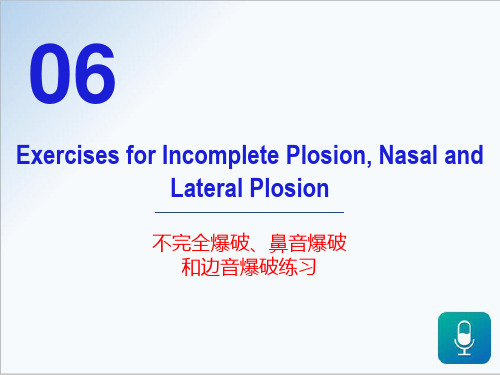
Exercises for Incomplete Plosion, Nasal and Lateral Plosion
不完全爆破、鼻音爆破 和边音爆破练习
前一个爆破音 只做发音口形 却不爆破出来
(1) 爆破音 + 爆破音 失去爆破
(2) 爆破音 + 摩擦音/ 破擦音 不完全爆破
(3) 爆破音 + 鼻音 / 舌边音 不完全爆破
Incomplete Plosion
不完全爆破
不完全爆破是连贯语流中 自然产生的语音现象。 出现在一口气读完的一个 语音单位内。
September
td
put down
“舌边爆破”
爆破音和舌边音 六个爆破音: /p//b//t//d//k//g/ 一个舌边音: l
发音规则
爆破音后面紧跟着的是舌侧音[l时,爆破音发生 不完全爆破,就叫舌边爆破。
• just think • a thousand
thanks • get through • take three • bright thought • the right thing • abstract theory • black thread • get there • just then • take this • ask them
2) Plosives + fricatives
• friendship first • old friends • step forward • red flags • a bright future • sweet flowers • ripe fruit • a complete failure • advance • advice • a kind voice • a one-sided view • first visit • second volume
大学一年级听力教学教案
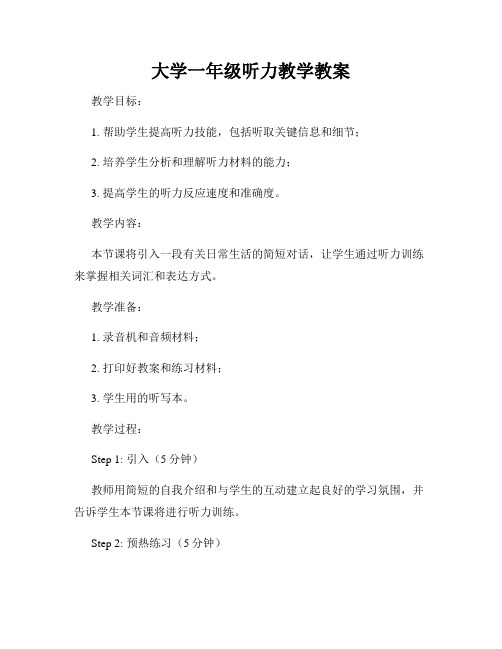
大学一年级听力教学教案教学目标:1. 帮助学生提高听力技能,包括听取关键信息和细节;2. 培养学生分析和理解听力材料的能力;3. 提高学生的听力反应速度和准确度。
教学内容:本节课将引入一段有关日常生活的简短对话,让学生通过听力训练来掌握相关词汇和表达方式。
教学准备:1. 录音机和音频材料;2. 打印好教案和练习材料;3. 学生用的听写本。
教学过程:Step 1: 引入(5分钟)教师用简短的自我介绍和与学生的互动建立起良好的学习氛围,并告诉学生本节课将进行听力训练。
Step 2: 预热练习(5分钟)教师播放一段简短的对话,并要求学生简单回答一个问题。
这段对话将涉及本课所学的相关词汇。
Step 3: 听力练习(15分钟)教师播放一段较短的对话,让学生仅通过听力理解对话内容,然后回答相关问题。
教师可以在播放前向学生简单介绍对话的背景,并强调学生要注意听取关键信息和细节。
Step 4: 听力理解(15分钟)教师播放一段较长的对话或短文,要求学生在听完后回答一系列问题,检验他们对听力材料的理解和分析能力。
Step 5: 听力反馈(10分钟)教师和学生一起讨论问题的答案,并听取学生对听力内容的反馈和理解。
Step 6: 听写练习(15分钟)教师将一段较长的对话或短文的部分内容播放给学生,让他们用听写本记录所听到的内容,并在播放完毕后互相核对答案。
Step 7: 总结与拓展(5分钟)教师总结本节课的重点,强调学生在平时的学习中要积极锻炼听力技能,建议学生可以通过听英语广播、观看英语电影等方式来提高自己的听力水平。
教学延伸:为了进一步提高学生的听力能力,可以在课后布置一些听力训练的作业,如听写、听力理解题等。
同时,鼓励学生积极参与英语角、参观英语俱乐部等实践活动,扩大他们的语言环境,加深对英语听力的感知和理解。
以上是一节针对大学一年级学生的听力教学教案,通过设计合适的听力练习内容和相应的活动,帮助学生提高听力技能和理解能力。
大学英语语音学教案

教学对象:大学一年级学生教学目标:1. 使学生掌握英语语音学的基本概念和理论。
2. 培养学生正确发音、辨音和语调的能力。
3. 提高学生的英语听说能力,为后续英语学习打下坚实基础。
教学重点:1. 英语音标及其发音规则。
2. 英语音节结构及其发音特点。
3. 英语语调、节奏和连读等语音现象。
教学难点:1. 辨析英语音标及其发音。
2. 英语语调、节奏和连读等语音现象的掌握。
教学准备:1. 教学课件、教材、录音机、电脑等教学设备。
2. 英语语音学相关教学视频。
教学过程:一、导入1. 向学生介绍英语语音学的重要性。
2. 简述本节课的学习目标和内容。
二、英语音标及其发音规则1. 介绍英语音标的发展历程和分类。
2. 讲解十二个单元音、八个双元音、五个三元音和十一个困难辅音的发音。
3. 通过实际例子,让学生掌握音标发音的技巧。
三、英语音节结构及其发音特点1. 讲解英语音节的构成和分类。
2. 分析光杆音节、半包围音节和全包围音节的发音特点。
3. 通过练习,让学生熟练掌握英语音节的发音。
四、英语语调、节奏和连读1. 介绍英语语调的基本概念和分类。
2. 分析英语语调在句子中的运用。
3. 讲解英语节奏的特点和表达方式。
4. 通过实际例子,让学生掌握英语连读的技巧。
五、课堂练习1. 学生跟读音标,教师纠正发音。
2. 学生朗读句子,教师纠正语调、节奏和连读。
3. 学生分组练习,互相纠正发音和语音现象。
六、总结1. 回顾本节课所学内容。
2. 强调英语语音学在英语学习中的重要性。
3. 布置课后作业,巩固所学知识。
教学评价:1. 课堂表现:观察学生课堂参与度、练习情况等。
2. 课后作业:检查学生课后练习的完成情况。
3. 考试:通过语音测试,评价学生的语音水平。
教学反思:1. 教学过程中,关注学生的个体差异,因材施教。
2. 注重培养学生的语音意识,提高学生的语音能力。
3. 创设丰富的教学情境,激发学生的学习兴趣。
4. 不断改进教学方法,提高教学质量。
教案大学一年级听力教学指导

教案大学一年级听力教学指导随着教育改革的不断深入,教师们对于教学质量的要求也越来越高。
尤其是在英语教学中,听力教学一直是教师和学生们关注的焦点。
为了提高一年级学生的听力水平,本文将给出一份针对大学一年级学生听力教学的指导教案。
教学目标:1. 帮助学生熟悉英语语音,提高听力判断能力;2. 提高学生的听力理解能力,培养学生的听力记忆能力;3. 培养学生的听力应用能力,让学生能够在实际场景中运用所学知识。
教学资源准备:1. 多媒体设备,包括投影仪、音响等;2. 听力材料,例如录音机、CD等;3. 学生练习册及听力练习材料;4. 包括图片、PPT等辅助教学材料。
教学步骤:Step 1:导入引入今天的主题,通过播放一段简单的短语音,让学生进入学习状态。
让学生预习本节课要听的内容,并简要介绍将要出现的关键词和短语,激发学生的兴趣。
Step 3:正式教学1. 首先,播放录音材料,让学生进行全文听力,不要求完全理解,只需尽量抓住主要信息。
2. 听完录音后,教师可以将关键听力内容呈现在屏幕上,让学生一起回顾确认答案。
3. 针对听力中的重点词汇、语法结构或表达方式,进行详细解释和示范。
引导学生理解并模仿。
4. 进行听力练习,可采用单项选择题、填空题等形式,检测学生对听力材料的理解程度。
Step 4:拓展为了拓宽学生的听力领域和提高学生的应用能力,可通过以下方式进行拓展:1. 组织学生进行小组听说训练,提高学生的听说配合能力。
2. 鼓励学生多听多说,通过外语环境的营造来提高学生的听力听说能力。
3. 提供更多的听力材料,例如新闻、访谈、影视片段等,让学生在不同场景中进行听力练习。
复习当天的教学内容,总结学生在听力方面取得的进步,并对下节课的内容进行预告。
教学评价:1. 教师应时刻留意学生的学习情况,及时调整教学策略,确保教学的有效进行。
2. 在选拔或制作听力材料时,应尽量贴近学生的实际生活,让学生对所学内容产生兴趣。
3. 评价学生的听力水平时,要注意综合考虑学生在听力材料理解、词汇掌握、语音语调等方面的表现。
大学一年级英语语音练习手册 教案

教案课程名称:英语语音总学时/周学时:授课班级:英语专业授课教师:Chapter 1 List of Phonetic Symbols音标的列表Phonetic symbols play an important role in English pronunciation.The purpose for us to learn phonetic symbols is to know how to read new words or how to correct your pronunciation according to the rule of phonetic symbols.In simple words, you know how to read words at the sight of their phonetic symbols.Altogether there are 48 phonetic symbols in English, twenty vowels and twenty-eight consonants.1.English Vowel 英语元音2.English Consonants 英语辅音The difference between vowels and consonants mainly lies in the fact that there is no block in the mouth cavity when pronouncing vowels, but there is some block when pronouncing consonants.Chapter 2 Simple Classification of English Vowels and Consonants英语元音和辅音的简单分类发音要领:元音,与辅音相对。
在发音过程中,气流通过口腔,而不受任何阻碍。
大学英语语音训练教案

课时安排:2课时教学目标:1. 帮助学生掌握英语元音和辅音的发音规则;2. 培养学生正确运用重音、语调和节奏的能力;3. 提高学生的英语口语表达能力。
教学重点:1. 元音和辅音的发音;2. 重音、语调和节奏的运用。
教学难点:1. 元音和辅音的发音准确性;2. 重音、语调和节奏的运用。
教学内容:1. 元音和辅音的发音;2. 单词和句子的重音;3. 句子的语调和节奏。
教学过程:第一课时:一、导入1. 利用多媒体展示英语语音的重要性;2. 学生分享自己学习英语语音的经验和困难。
二、元音和辅音的发音1. 教师讲解元音和辅音的发音规则;2. 学生跟读并模仿教师的发音;3. 分组练习,互相纠正发音错误。
三、单词和句子的重音1. 教师讲解单词和句子的重音规则;2. 学生跟读并模仿教师的重音发音;3. 分组练习,互相纠正重音错误。
四、句子的语调和节奏1. 教师讲解句子的语调和节奏规则;2. 学生跟读并模仿教师的语调和节奏;3. 分组练习,互相纠正语调和节奏错误。
第二课时:一、复习1. 复习元音和辅音的发音;2. 复习单词和句子的重音;3. 复习句子的语调和节奏。
二、巩固练习1. 学生自选一段英语材料,进行发音、重音、语调和节奏的练习;2. 学生展示练习成果,教师点评并指导。
三、课堂活动1. 学生分组进行对话练习,运用所学的语音知识;2. 教师随机抽查学生的发音、重音、语调和节奏,给予指导和反馈。
四、总结1. 教师总结本节课的学习内容;2. 学生分享学习心得和收获。
教学评价:1. 学生在课堂上的参与度和积极性;2. 学生对元音、辅音、重音、语调和节奏的掌握程度;3. 学生在课堂活动中的表现和进步。
英语语音教学计划计划(精选13篇)
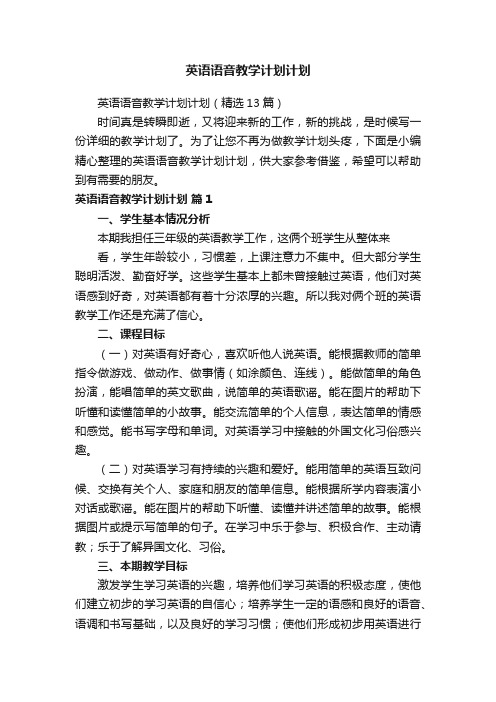
英语语音教学计划计划英语语音教学计划计划(精选13篇)时间真是转瞬即逝,又将迎来新的工作,新的挑战,是时候写一份详细的教学计划了。
为了让您不再为做教学计划头疼,下面是小编精心整理的英语语音教学计划计划,供大家参考借鉴,希望可以帮助到有需要的朋友。
英语语音教学计划计划篇1一、学生基本情况分析本期我担任三年级的英语教学工作,这俩个班学生从整体来看,学生年龄较小,习惯差,上课注意力不集中。
但大部分学生聪明活泼、勤奋好学。
这些学生基本上都未曾接触过英语,他们对英语感到好奇,对英语都有着十分浓厚的兴趣。
所以我对俩个班的英语教学工作还是充满了信心。
二、课程目标(一)对英语有好奇心,喜欢听他人说英语。
能根据教师的简单指令做游戏、做动作、做事情(如涂颜色、连线)。
能做简单的角色扮演,能唱简单的英文歌曲,说简单的英语歌谣。
能在图片的帮助下听懂和读懂简单的小故事。
能交流简单的个人信息,表达简单的情感和感觉。
能书写字母和单词。
对英语学习中接触的外国文化习俗感兴趣。
(二)对英语学习有持续的兴趣和爱好。
能用简单的英语互致问候、交换有关个人、家庭和朋友的简单信息。
能根据所学内容表演小对话或歌谣。
能在图片的帮助下听懂、读懂并讲述简单的故事。
能根据图片或提示写简单的句子。
在学习中乐于参与、积极合作、主动请教;乐于了解异国文化、习俗。
三、本期教学目标激发学生学习英语的兴趣,培养他们学习英语的积极态度,使他们建立初步的学习英语的自信心;培养学生一定的语感和良好的语音、语调和书写基础,以及良好的学习习惯;使他们形成初步用英语进行简单日常交流的能力。
同时,能听懂、会说12组对话,并能进行简单的交流;能听、说、读、写73个单词并进行简单地运用;适当介绍中西方文化,培养学生爱国主义精神,增强世界意识,为学生的进一步学习奠定良好的基础。
四、教学措施1.认真备课,钻研教材,抓紧课堂教学,做到当堂内容当堂掌握。
2.运用各种不同的肢体语言来辅助教学。
大学英语语音课教案

课程名称:大学英语语音授课对象:大学一年级学生课时:2课时教学目标:1. 认知目标:使学生掌握英语音标的基本知识,包括元音和辅音的发音规则和特点。
2. 功能目标:提高学生的英语发音准确性,增强学生的听力理解能力。
3. 意义目标:通过语音学习,帮助学生更好地进行英语听说交流,提高英语综合运用能力。
教学重点:1. 元音和辅音的发音规则。
2. 英语句子节奏和重音的把握。
教学难点:1. 辅音的发音位置和发音方法。
2. 节奏和重音在句子中的运用。
教学过程:第一课时一、导入1. 引导学生回顾初中阶段所学的音标知识,激发学生学习兴趣。
2. 提问:大家在学习英语过程中,有没有遇到发音不准确的问题?二、新课导入1. 讲解元音的发音规则,通过图片、视频等多媒体手段展示元音的发音特点。
2. 演示元音的发音方法,并让学生跟读练习。
三、课堂练习1. 分组练习,每组选出一个代表进行发音展示,其他组员进行纠正和评价。
2. 播放元音发音标准录音,让学生跟读,教师逐一纠正发音错误。
四、总结1. 强调元音发音的重要性,要求学生课后多加练习。
2. 布置作业:模仿元音发音标准录音,进行跟读练习。
第二课时一、复习1. 回顾上节课学习的元音发音规则。
2. 让学生进行元音发音展示,教师点评。
二、新课导入1. 讲解辅音的发音规则,通过图片、视频等多媒体手段展示辅音的发音特点。
2. 演示辅音的发音方法,并让学生跟读练习。
三、课堂练习1. 分组练习,每组选出一个代表进行发音展示,其他组员进行纠正和评价。
2. 播放辅音发音标准录音,让学生跟读,教师逐一纠正发音错误。
四、节奏和重音1. 讲解英语句子节奏和重音的把握方法。
2. 演示节奏和重音在句子中的运用,让学生跟读练习。
五、总结1. 强调节奏和重音在英语发音中的重要性,要求学生课后多加练习。
2. 布置作业:模仿节奏和重音标准录音,进行跟读练习。
教学反思:1. 教师应关注学生的发音情况,及时纠正发音错误,提高学生的发音准确性。
大学一年级英语语音练习手册 Chapter 5

会浊化成其相对的爆破音 / b, d, g /。
2. 重读音节。
单音节词: school中,ch本来要发\k\的音,但现在 要发\g\的音,此种情况还有skin,storm, strange等。
多音节词: respect,重读在第二个音节,所以s后的 /k/要读成/g/。
三个辅音在—起发音时候: 如果中间那个是清辅音,也要浊化的。 比如: spring,音标为/spr/,因前三个辅音,要浊化 读成/sbr/.
05
Exercises for Consonant Clusters
辅音连缀练习
Consonant clusters
辅音连缀
在英语中, 在同一意群内 (通常为一个单词内), 如果有两个或两个以上的 辅音音素结合在一起, 这种语音现象称为辅音连缀。
Consonant clusters
辅音连缀
词首: 前面辅音 辅音1+辅音2+辅音3+元音+… 轻读短促 spy 不夹元音 spring 衔接紧密 splash 过度自然
seems harms sons means girls miles sings songs words
Voiceless +/t/
stopped stepped asked kicked kissed missed washed finished watched touched
2. Final 词尾的辅音连缀
2. Final 词尾的辅音连缀
Voiced +/dz/
fields shields wields folds holds ends spends pretends extends
Summary
2
- 1、下载文档前请自行甄别文档内容的完整性,平台不提供额外的编辑、内容补充、找答案等附加服务。
- 2、"仅部分预览"的文档,不可在线预览部分如存在完整性等问题,可反馈申请退款(可完整预览的文档不适用该条件!)。
- 3、如文档侵犯您的权益,请联系客服反馈,我们会尽快为您处理(人工客服工作时间:9:00-18:30)。
《英语语音》教学大纲
一、课程名称:英语语音
二、课程类别:专业选修课
三、教学时数:周学时数2 ,总学时数20
四、学分:2
五、开课时间:第二学期
六、开课专业:英语专业
七、教学对象:英语专业本科一年级学生
八、教学目的:英语语音课的目的是向学生系统介绍英语语音和语调的知识,使学生通过学习和练习掌握英语的发音、语流的规律、语调的功能,基本上能正确使用英语语音、语调朗读、表达思想并进行交际。
九、课程内容:本课程要求以学生练习为主,从听辨语音、语调能力的培养入手,将听力、发音与口头表达三方面的训练紧密结合起来,既强调基本功的训练,又注意活用练习。
教学内容要求突出以下几方面:(1) 英语音素的正确发音方法、辨音能力、模仿能力综合训练;(2) 英语的单词重音及语句重音的基本规律、表现形式、表意功能的讲授与训练;(3) 英语语流的节奏规律、基本特征、基本要素、强∕弱读式的训练; (4) 英语所特有的语音、语调的结构、功能及其在交际中的运用。
十、教学时间安排:
学期周内容学时
第一学期1
Pretest, Unit 1 Basic Concepts: Syllables, Stress &
Rhythm
2 2Unit 2 Consonants: Stops 2 3Unit
3 Consonants: Fricatives & Affricates 2 4
Unit 4 Consonants: Nasals, Approximants &
Lateral(s)
2 5Unit 5 V owels: Front V owels & Central V owels 2
6 Unit6 V owels: Back V owels 2
7 Unit 7 V owels: Diphthongs 2
8 Unit 8 Stressed Syllables & Unstressed Syllables 2
9 Unit 9 Stressed Words & Unstressed Words in a Sentence
2
10 Unit 10 Strong Forms & Weak Forms 2
11 Unit 11 Linking 2
12 Unit 12 Rhythm of English Speech 2
13 Unit 13 Types of Intonation in English 2
14 Unit 14 Intonation Units of English 2
15 Unit 15 Functions & Uses of English Intonation 2
十一、所用教材:
(1)《英语语音教程》王桂珍编著高等教育出版社, 2000
(2)《大学一年级英语语音练习手册》张冠林编外语教学与研究出版社, 1988
十二、教学参考书目:
(1)《国际音标与语音》汪福祥李孚声著外文出版社, 1999
(2)《国际音标与语音语调》张卓宏王文广等著清华大学出版社, 2003 (3)Cruttenden, A. Gimson's Pronunciation of English,外语教学与研究出版社,2000
(4)Hancock, M. English Pronunciation in Use, Cambridge University Press, 2003
(5)Roach, P. English Phonetics and Phonology, Cambridge University Press, 1983.
十三、考核方式:学期末考试与平时成绩和课堂表现相结合。
期末笔试占总分的30%,口试占总分的50%,平时表现占总分的20%,以百分制计算。
本大纲制定人:孙悦。
